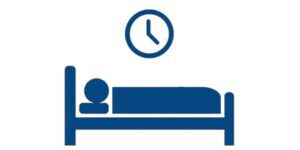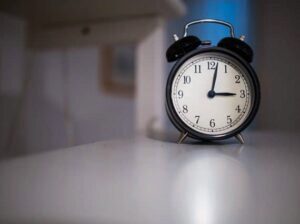REM Sleep
Disclosure: By clicking on the product links in this article, Mattress Nerd may receive a commission fee at no cost to you, the reader. Read full disclosure statement.
Sleep consists of five stages. Each one falls into two categories. The first three stages occur during non-rapid eye movement sleep (NREM). But, the final two are a part of rapid eye movement sleep (REM).
A healthy sleep cycle experiences each step several times per night. It allows your brain and body to recover and develop. It also converts short-term memories to long-term memories and archives what you’ve learned that day.
Here’s everything you need to know about REM sleep and how to get more of it.
Video Breakdown

What is REM sleep?
REM sleep occurs about 90 minutes after you fall asleep. Why is it called “rapid eye movement” sleep? Because your eyes scurry from side to side during this sleep stage.
Your brain is also very active in this state. In fact, during REM sleep, your brain waves can resemble their levels when you’re awake.
Other ways your body reacts in REM sleep are:
- Breathing is faster and more irregular
- Heart rate speeds up
- Blood pressure increases
- Dreaming usually occurs
- Arms and legs become temporarily paralyzed
As you get older, you’ll typically spend less time in REM sleep. Your circadian rhythm can also change with age.
Why do you need REM sleep?
REM sleep is still a bit of a scientific mystery. Experts have different theories about it and its importance to our health. Here are some of the reasons your body may need REM sleep:
- Brain development. Newborns spend a significant amount of time in REM sleep. This could be due to their small size, but some scientists believe it signals REM’s important for brain development.
- Enhanced sensory reaction. You’ll often experience muscle twitching during REM sleep. This could aid your sensorimotor development, especially activity-related motor skills.
- Memory consolidation. REM sleep might help your brain might convert recently learned experiences into long-term memory at this sleep stage.
Experts point to other possible functions of REM sleep, like improving overall brain health and enhancing creativity.
REM sleep vs. deep sleep
Non-rapid eye movement (NREM) sleep occurs in several stages. The first stage of NREM sleep only lasts for a few minutes. During this period, you’re only lightly asleep and your heart rate and breathing slow down.
Then, you’ll drift into a deep sleep. Humans spend an estimated 75 percent of their time sleeping in an NREM cycle and 25 percent in a deep sleep.
Unlike REM sleep, during this third stage of deep NREM, your:
- Heartbeat and blood pressure are at their lowest
- Your body temperature drops
- Muscles relax
- It isn’t easy to wake you up
- Brain waves slow down
Similar to REM sleep, you’re also typically a little foggy if you wake up from a deep sleep. You may experience some mental impairment for an estimated 30 minutes to an hour. This phenomenon is known as sleep inertia.
Deep sleep works to repair your body by:
- Repairing and regrowing tissue
- Building bone and muscle
- Strengthening the immune system
How much REM sleep do you need?
The total amount of sleep you need depends on your age. Here are the recommended hours of sleep per day:
- 0-3 months: 14-17 hours
- 4-12 months: 12-16 hours
- 1-2 years: 11-14 hours
- 3-5 years: 10-13 hours
- 6-12 years: 9-12 hours
- 13-18 years: 8-10 hours
- 18-60 years: 7 or more hours
- 61-64 years: 7-9 hours
- 65 years and older: 7-8 hours
Typically, people spend 25 percent of their total night’s rest in REM sleep. So, for example, if you sleep 8 hours, you’ll experience 2 hours of REM sleep.
How to get more REM sleep
A great way to get more REM sleep is by practicing good sleep hygiene. Here are some tips to enhance the quality of your sleep.
Stick to a regular sleep schedule
Whenever possible, try to create a habit of going to bed and waking up at the same time each day. Yes, even on weekends. Excessive time in bed can actually lead to poor sleep quality.
In time, you’ll start to regulate your circadian sleep cycle and improve your chances of a good night’s rest.
Limit how you use your bed
Use your bed for only sleep and sex. This will help your brain equate the bed to sleep, which could help you to fall asleep faster.
Consider getting out of bed when you can’t fall asleep within 20 minutes of hitting the pillow and only returning when sleepy. Try to avoid using your bed to work, watch television, or read.
Avoid napping when you can
Daytime naps may make you more sleepy. If you do take naps, it’s best to take them consistently each day and limit them to only 30 minutes.
Get into a bedtime routine
You may fall asleep faster and longer if you perform a nightly routine. For example, at the same time each night, you brush your teeth, meditate, and set the alarm clock. Following a ritual may also help regulate your circadian rhythm.
Sleep-conducive environment
When you lie down at night, pay attention to your environment. It should be relaxed, dark, and quiet. If needed, try using a sleep mask, earplugs, or a white noise machine. Ensure the bedding is comfortable with the right size pillow and a cozy blanket.
Exercise regularly
Exercise helps improve sleep quality. It may also reduce stress which can also make it easier to fall asleep. Just keep in mind that it’s best to avoid exercising late in the evening since it might keep you awake.
Leave time for relaxing
Make sure your nightly routine includes time for widning down. For example, reading quietly or taking a warm bath. It’s difficult to fall asleep when stressed or worried.
Relaxation techniques like breathing exercises and visual imagery may also help quiet your mind.
Avoid caffeine and alcohol
Caffeine and appetite suppressants stimulate your brain, making sleep difficult. Also, drinking alcohol works as a diuretic causing you to urinate throughout the night. You might consider avoiding them both for improved sleep quality.
REM sleep disorders
Sleep disorders can occur in all stages of sleep. REM sleep disorders typically occur in the latter part of the night. These include:
- REM sleep behavior disorder (RSBD). Causes you to act out your dreams while you’re still asleep.
- Night terrors. Episodes of frightening dreams that can cause the sleeper’s body to lash out.
- Sleep paralysis. You feel conscious but are unable to move as if you’re still asleep.
When to see your doctor
You may consider speaking with your doctor if you aren’t getting the recommended hours of sleep or if you’re sleeping too much. Other symptoms that might be a sign of a sleep disorder include:
- daytime sleepiness
- irritability
- lack of muscle control
- falling asleep at unusual times
- snoring regularly
There are many different sleep disorders. Speaking with your doctor about your symptoms can help ensure you receive a proper diagnosis. Then, you can discuss the treatment options available.
Takeaway
There’s still so much to learn about why humans sleep. It’s clear, though, that you need sleep to function and live a healthy life. Your body needs both REM and NREM sleep.
Prioritize good sleep hygiene to make sure you’re not missing out on either. Also, speak with your doctor if you’re having trouble sleeping. They can help identify any medical issues and recommend personalized treatment.
Source List
Brain basics: Understanding sleep. (2022). https://www.ninds.nih.gov/health-information/public-education/brain-basics/brain-basics-understanding-sleep
Feriante J, et al. (2022). Physiology, REM sleep. https://www.ncbi.nlm.nih.gov/books/NBK531454/
Hood S, et al. (2017). The aging clock: Circadian rhythms and later life. https://www.ncbi.nlm.nih.gov/pmc/articles/PMC5272178/
How much sleep do I need? (2022). https://www.cdc.gov/sleep/about_sleep/how_much_sleep.html
Patel A, et al. (2022). Physiology, sleep stages. https://www.ncbi.nlm.nih.gov/books/NBK526132/
Peever J, et al. (2018). The biology of REM sleep. https://www.ncbi.nlm.nih.gov/pmc/articles/PMC5846126/
Pham C, et al. (2022). Rapid eye movement sleep behavior disorder. https://www.ncbi.nlm.nih.gov/books/NBK555928/
Schwab, R. (2022). Overview of sleep. https://www.msdmanuals.com/home/brain,-spinal-cord,-and-nerve-disorders/sleep-disorders/overview-of-sleep
Sleep hygiene. (2022) https://www.merckmanuals.com/professional/multimedia/table/v41413035
Van Horn N, et al. (2022). Night terrors. https://www.ncbi.nlm.nih.gov/books/NBK493222/


